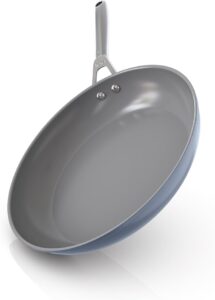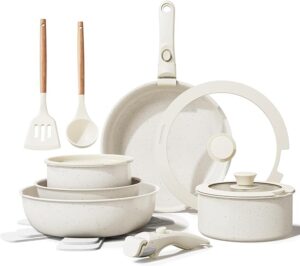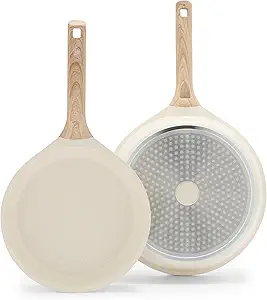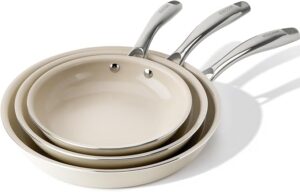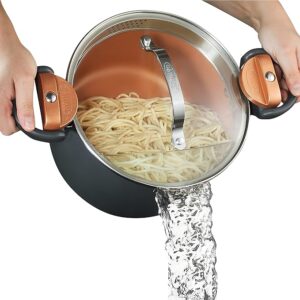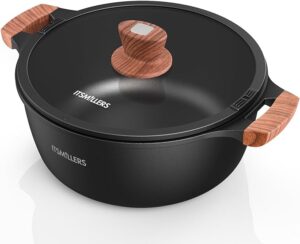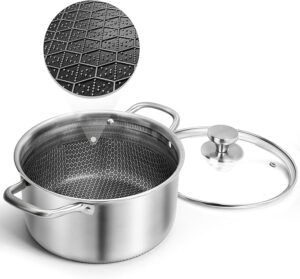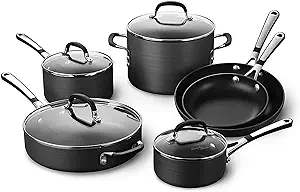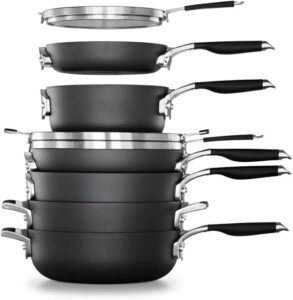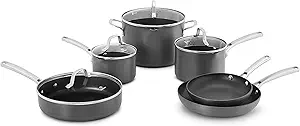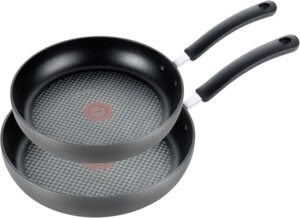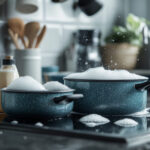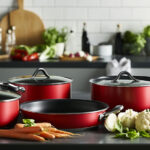How to Safely Use Frying Pans and Pots: A Guide to Healthy Cooking
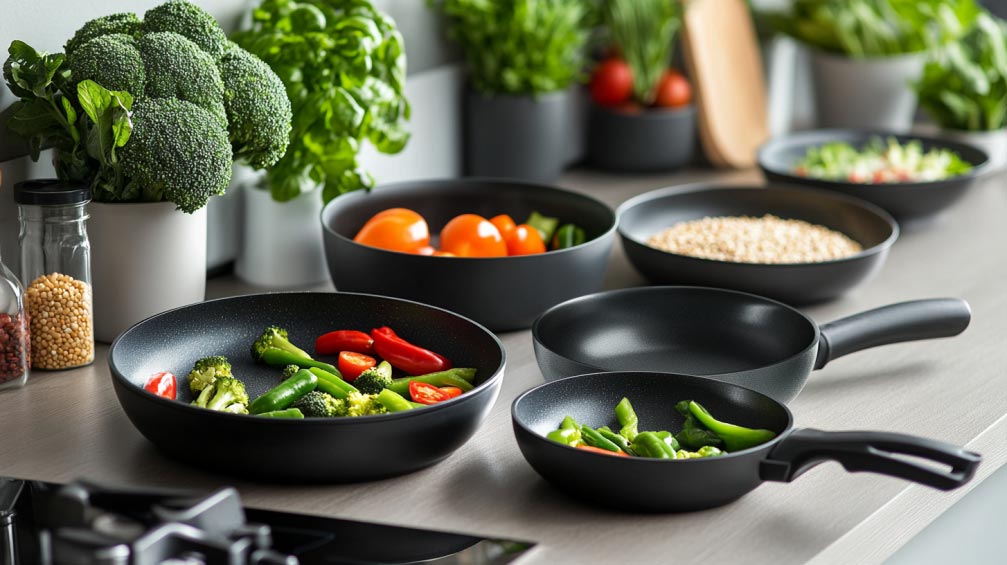
Healthy kitchen basics require the right cooking techniques and cookware. Whether it is frying, sautéing, or simmering, it’s super important to know how to use non-stick pans safely both for health reasons and to extend their lifetime. Non-stick pans may be convenient in use, but with poor practice, they could allow the release of chemicals into food or have their usable lifetime shortened. This guide looks into the best ways of using frying pans and pots safely, with attention to healthy cooking and non-toxic alternatives to cookware, enabling one to make knowledgeable choices within the home kitchen.
Choose the Right Cookware Materials
While preparing healthy meals, the material used in cookware plays an important role, just like the ingredients. If you think of nontoxic cookware standing behind your health-conscious cooking, it is crucial to understand the benefits and possible risks of different materials. Why stainless steel, cast iron, and ceramic pans beat the safety record of non-stick coatings like Teflon, and how anodized aluminum and ceramic cookware can further improve the health aspects of your kitchen.
1. Stainless Steel: Durable and Non-Reactive
Consequently, stainless steel is one of the most popular choices for those planning to get healthy cookware materials due to the following reasons:
- It is non-reactive: It wouldn’t leak metals or chemicals into one’s food as elements of aluminum or copper would do, and for this very reason, is considered great to use even with acidic foods like tomatoes or citrus-based dishes.
- It is indeed tough: stainless steel cookware doesn’t rust that easily; neither does it scratch nor warp under any temperature, that will surely serve them for a couple of years with proper care.
- It is Versatile: Stainless steel pans are great for sautéing, frying, boiling, and browning without compromising any part of food quality or safety.
How to Use:
- Preheat the pan before the addition of food to prevent sticking.
- A little oil or butter will suffice, since stainless steel does not contain the non-stick surface of a Teflon pan.
2. Cast Iron: Naturally Non-Stick and Fortifies Your Food
Cast iron pans have been serving cooks worldwide for ages. The toughness and nontoxicity of the material are a few reasons why cooks like cast iron. Cooking with cast iron provides added health benefits from the cookware itself, and some of them include:
- Naturally Non-Stick: A well-seasoned cast iron will naturally give you a nontoxic nonstick surface.
- Iron Fortification: Cooking in cast iron tends to add small amounts of iron to your food, thereby helping a lot of people who have been suffering from iron deficiency.
- Durability: If properly well cared for, then cast-iron cookware can last a lifetime.
How to Use:
- Season your pan regularly by applying a thin layer of oil and heating it.
- Avoid cooking too acidic food for a long period of time, because this may wear away the seasoning.
3. Ceramic Pans: Non-Toxic and Environmentally Friendly
Ceramic cookware is a great option for classic non-stick pans, as it derives from natural materials and doesn’t use artificial chemicals. Key benefits among them include the following:
- Non-Toxic Surface: Ceramic pans are free of toxic materials, such as PTFE or PFOA, which can be found in the coating of some cookware types like Teflon.
- Even Cooking: Ceramic has good heat distribution, hence reducing spots that may burn your food.
- Eco-Friendly: Ceramic is an environment-friendly material owing to its ingredients, which are natural minerals.
How to Use:
- Ceramic pans work best on low to medium heat; this will extend their lifetime.
- Hand wash using mild detergent to avoid coating damage.
4. Anodized Aluminum: Lightweight and Safe for Cooking
Anodized aluminum cookware is a non-toxic, durable alternative to raw aluminum, which can be reactive with certain foods. Here’s why:
- Non-Reactive: The process of anodizing forms a hard, non-reactive surface that does not easily corrode and prevents leaching in food.
- Strong and Scratch Resistance: It is harder compared to the usual aluminum metal; hence, it will not warp or get damaged easily.
How to Use:
- You can prepare any sort of food, including acidic dishes, without having to put much thought into a probable reaction with the metal involved.
- Avoid using abrasive sponges to maintain the integrity of the surface.
5. Ceramic-Coated Cookware: A Non-Stick, Non-Toxic Alternative
If you like the convenience of non-stick but want something healthier, then ceramic-coated cookware might be just what you need. Here’s what they have in store for you:
- Nonstick Properties Without Chemicals: The ceramic coatings would provide a smooth, nontoxic surface with no PTFE and PFOA-type chemicals.
- Health and Safety: Ceramic coating is resistant to high temperatures and will not emit those toxic fumes compared to traditional non-stick coatings.
How to Use:
- Do not use it under high heat because normally this cuts down the life of a ceramic coating. It is also good to use non-metal utensils.
- It is best for low-fat cooking because barely any amount of oil is required in a pan with a ceramic coating.
Conclusion: Choosing Healthy Cookware Materials
Are you looking for non-toxic cookware? Choose stainless steel, cast iron, ceramic, or hard-anodized aluminum to get healthier and safer cooking. While Teflon nonstick pans are very easy to use, they are health hazards unless great care is taken in their use. You will be able to limit exposure to potential harm by preparing nutritious meals for your family because you are choosing healthier cookware materials that are non-reactive and chemical-free.
Knowing the properties of each will help you decide which one to use and which one serves the best in your kitchen, with greater awareness of durability and safety.
Avoid Cooking at High Temperatures
The most important thing that one should consider is the high-temperature cooking might be dangerous for your food and, for that matter, your cookware, mainly the non-stick pans. Overheating may release poisonous fumes and damage the non-stick coating of such pans, thus reducing their efficiency and life cycle. A few simple facts about high-heat cooking can help you reduce these risks and ensure safety along with a long life.
1. How Overheating Non-Stick Pans Can Release Harmful Fumes
Non-stick pans are often treated with Teflon, the brand name for a synthetic polymer called PTFE, for convenience and ease of use. However, these definitely have temperature limits. When non-stick pans are overheated, especially above 500°F (260°C), the PTFE coating may start breaking down and releasing toxic fumes, which can be dangerous upon inhalation.
- Teflon Flu: These fumes, when exposed to under uncommon circumstances, can result in symptoms of flu, generally known in humans as polymer fume fever.
- Pet Safety Caution: This is very dangerous, especially for birds whose respiratory system can be extremely sensitive. Cooking in non-stick pans at high heat greatly increases health risks for pets.
Safe cooking methods coupled with the avoidance of deterioration of your cookware should help one avoid these dangers.
2. Safe Cooking Temperature for Non-Stick Pans
For safely and efficiently using non-stick pans, one has to stay within recommended safe cooking temperature ranges. The general guidelines are as follows:
- Optimal Cooking Temperature: The optimal temperature limits with which a non-stick pan can be used range from 200°F – 400°F (93°C – 204°C). In that temperature range, the coating works very effectively without degradation.
- Preheating Safety: The pan does not need to be preheated above the low to medium heat level. Never preheat an empty pan. It can reach unsafe temperatures in just a few seconds, so just simply add oil or food to it for the meantime.
- Oven Use: Most non-stick pans should not be put in the oven, but check with the manufacture to be certain. Many non-stick pans have a temperature limitation of 350°F to 400°F if used in an oven; however, this temperature can vary depending on the brand.
By keeping a safe cooking temperature for non-stick pans, one avoids damaging the coating and keeps the kitchen a safe place.
3. How High Heat Damages Non-Stick Coatings
Nonstick coatings-PTEE, better known as Teflon among others-have a temperature limit. If you overly heat a non-stick coating by preheating, searing, or frying too hot, the coating begins to break down. Here’s how this happens:
- Non-Stick Surface Degradation: Exposure to temperatures over 500°F for longer periods might even degrade the surface, causing it to either flake or bubble. Under such circumstances, the pan would lose its non-stick characteristics and potentially become hazardous to use for cooking.
- Chemical Degradation: Once the surface starts degrading, toxic chemicals can leach into your food in case the pan happens to be scratched or otherwise compromised.
Long-term care of non-stick pans involves avoiding high-heat cooking procedures like searing, broiling, or deep frying-requiring temperatures higher than what non-stick coatings can handle.
4. Tips for Maintaining Non-Stick Pans
The following are some helpful tips on how to use a non-stick pan without causing any damage to yourself or the pan and how you can extend its life:
- Cook at Low to Medium Heat: Take a medium or low heat setting. Nonstick pans work best at low to medium temperature cooking methods such as sautéing, simmering, and scrambling.
- Use Proper Utensils: Avoid using metal utensils, which scratch or damage the coating. Use wooden, silicone, or plastic instead.
- Avoid using rough cleaners: When washing up, use soft sponges and mild dish soap. The abrasive pad or strong reagents will wear down the non-stick surface. Hence, hand washing is preferred to prolong the life of the pan.
- Use Oils Sparingly: While the quantity required will be relatively less, as compared to other pans, a few drops of any cooking oil or butter protect the surface of the non-stick pan and aids in better cooking.
- Be Aware of the Condition of Your Pan: Replace your pan when you feel that the scratch, chipping, or peeling off the coat is intolerable. The more worn out your non-stick pan is, the less functional and safe it may be.
5. When to Replace Non-Stick Pans
Even with proper care, a non-stick pan will only last so long. A high-quality non-stick pan will usually last for 3-5 years with adequate care. Here are a couple of indications that it is time for a new pan:
- Scratches or Peeling: If the surface of your non-stick pan develops scratches or peels, it’s time to get another one. It is no longer very effective when this happens, and you do not want to ingest tiny flakes of the coating.
- Loss of Non-Stick Properties: In cases where food starts to stick, even after applying oil, the coating may be worn out.
- Discoloration or Warping: When the pan gets discolored or warped, it will never heat up evenly or cook the food well; this might result in its burning and releasing toxic fumes on high temperatures.
By noticing these wear and tear signs and following some temperature limits for safety, you can increase the life of your non-stick cookware.
Conclusion: How to Use Non-Stick Pans Safely by Avoiding High Temperatures
Using non-stick cookware has its conveniences in the kitchen; however, to safely use these pans, it is important not to cook on high temperatures. Overheating Non-Stick Pans Overheating a pan with non-stick coating releases fumes that can be harmful and it destroys the non-stick coating, making them less effective and even harmful to your health.
You make sure to stick within that safe cooking temperature of the nonstick pans, between 200°F and 400°F, and you also do good maintenance like using the right utensils, not preheating an empty pan, and handwashing. By doing so, your cookware may well last you many, many years. By keeping to low- to medium-heat cooking, you are assured that the non-scratch pans will remain one of the safest and most reliable tools you have in the kitchen.

Use Non-Toxic Utensils and Cleaners
The key to maintaining non-toxic cookware is proper selection of utensils and cleaning agents. Nonstick pans are widely popular, thanks to their convenience; however, their coatings are rather delicate. Improper use of inappropriate tools or harsh cleaning methods can expose the surface to damage, thus rendering short life and possibly even exposing your food to toxins. Best practices will entail the use of silicone, wood, or nylon utensils to avoid scratching the non-stick coating and ways of washing the non-stick pans for longevity.
1. The Importance of Using Non-Toxic Utensils
Non-stick coating, mainly the ones made from PTFE-known as Teflon-is scratch- and abrasion-prone. Wrong utensils like metal spatulas, tongs, or forks scratch the surface of such pans, making it wear down over time and losing their non-stick properties.
Sometimes, too, scratched non-stick coating has even been reported to leach harmful chemicals into your food. To keep your non-stick pans free from scratches and not carcinogenic, it is good to use nontoxic cookware utensils like silicone, wood, or nylon. Here is why these materials are suitable:
- Silicone Utensils: Soft, flexible, and elastic, silicone utensils have heat resistance and don’t scratch the coating of the non-stick pan. They’re all right for flipping, stirring, and mixing delicate foods, like eggs or pancakes.
- Wooden Utensils: The wood is an environmentally-friendly utensil material that doesn’t scratch or damage the non-stick coating. You have wooden spoons, spatulas, and ladles that don’t scratch or damage your cookware and are strong enough and very easy to clean.
- Nylon Utensils: Although nylon is a bit harder compared to silicone, this utensil material also doesn’t scratch the non-stick coating of your cookware. It’s heat-tolerant, tough to stir and serve heat foods without chancing chip in the non-stick coating.
These materials ensure your non-stick cookware does not scratch and retains its non-toxic properties to avoid toxins in cookware that may contaminate your food.
2. Best Cooking Utensils for Non-Stick Pans
The very first thing one considers when selecting some of the best cooking utensils that go with a non-stick pan is to get hold of some tool that will not scratch the surface. Mentioned below are some of them:
- Silicon Spatula: Great for flipping eggs, pancakes, or even fish, this one would be a spatula of flexible material, firm enough to manage such work delicately without scratching the surface.
- Wooden Spoon: This is an all-purpose utensil for stirring soups, sauces, and stews, and would work well in high-heat dishes without sustaining any damage to the non-stick coating.
- Nylon Ladle: Great for serving soups, stews, or liquids from a non-stick pot because a nylon ladle won’t scrape or chip your non-stick surface.
Besides these, always use your own choice of cookware according to the instructions on it provided by the manufacturer. Some nonstick pans are more sensitive to utensils and might have more ways to deal with how to use nonstick pans safely and thereby extending the life of such a pan.
3. Best Practices for Cleaning Non-Stick Pans
Cleaning your nonstick pans correctly is important as their usage. Safe cleaning tips for cookware help in preserving the coating and keeping your pan in good condition for a long time. Here are some best practices:
- Scratchy Scrubber Avoiders: Avoid using steel wool, scouring pads, or scrubbing sponges on non-stick pans. These scratch the pan and degrade the coating. Soft sponges or microfiber cloths-easy on the surface-can be used.
- Mild Detergents: Severe chemical cleaners strip off the non-stick coating and release residues that may be hazardous. Keep mild dish soap with warm water for cleaning your pan. Allow it to soak in when food is sticky on it, then gently scrub it.
- Best Hand-Washing: Although most of the non-stick pans are being marketed as dishwasher-safe, setting high temperatures and using high-strength detergents in the dishwasher can damage the layer through time. To keep your pans’ lifespan long, hand-wash them with warm soapy water and a soft sponge.
- Avoid High Heat While Cleaning: Clean a non-stick pan when it has reached a cool temperature. Sudden confrontation of a hot pan with cold water can cause thermal shock to the pan and, hence, warp or crack.
- Dry Thoroughly: Dry the pan with a soft towel after washing to keep the surface smooth and avoid water spots.
Following these safe cookware cleaning tips will keep your non-stick pans in great condition and won’t sacrifice any of the nontoxic cookware properties.
4. How to Prevent Toxins in Cookware
Probably the most serious concern about non-stick pans has to do with the potential to release toxins in case the coating becomes scratched or otherwise compromised. The following are ways of ensuring harmful chemicals never reach your plate:
- Avoid Toxic Utensils: As partially noted, utilizing utensils such as silicone, wood, or nylon prevents scratching and keeps the surface intact.
- Replacing Worn Pans: When your non-stick pans show wear and tear, such as peeling, flaking, or deep scratches all over, it is time to replace them. It’s not healthy to cook with a bad non-stick pan, as it might release chemicals into your food during cooking.
- Avoid overheating: try to use non-stick pans only on low to medium heat. Higher heats can break down the coating that makes the pan non-stick and can release some toxic fumes. Always practice safe cooking temperatures for nonstick pans to avoid overheating.
5. Maintaining Longevity of Non-Stick Pans
The following are some maintenance tips that may help keep non-stick cookware functional for longer:
- Medium to Low Heat: Because of this, cooking on medium to low heat can prevent its damage. In fact, for a non-stick pan, even sautéing, frying, and simmering is done at low to medium heat.
- Store carefully: try to avoid placing stacks of non-stick pans inside one another without a thin layer in between them. You can place pan protectors, dish towels, or paper towels between the pans for avoidance of scratch issues.
- Seasoning Your Pan (Optional): A few non-stick pans work better when they are lightly seasoned with oil first. You can lightly rub some oil onto the surface of a new pan, and briefly heat to fortify its non-stick properties before use.
6. Eco-Friendly Non-Toxic Cleaners
Those who want to go the extra mile in the care of their non-toxic cookware, well, consider using eco-friendly non-toxic cleaners. These cleaners will not contain harsh chemicals and therefore are safe for both your cookware and the environment. Look for cleaners that are biodegradable, phosphate-free, and meant for delicate surfaces.
In Summary: How to Use Non-Stick Pans Safely with Non-Toxic Utensils and Cleaners
To use a non-stick pan both safely and non-toxically, one needs to choose appropriate, non-toxic utensils for cookware and clean it safely. Non-abrasive utensils, made of silicone, wood, or nylon, will not scratch the non-stick coating, while good cleaning practices include the use of soft sponges, mild detergents, and washing by hand to keep your pans in great shape.
In this way, you won’t damage the coating or expose it to harsh chemicals that may render your cookware toxic, keeping it safe and functional for years. And following these safe cookware cleaning tips will also help you stay away from toxins in cookware, making your cooking environment healthy for you and your family.
Replacing Cookware: When It Wears Out
Healthy cooking is important, and that entails the use of proper cookware. However, even the best of pots and pans do not last a lifetime. Over time, they may wear out, and using damaged or deteriorated cookware could present one with health risks. It is important to learn how to look out for signs of wear on a non-stick frying pan and pot, which may appear as scratches or peeling coatings, and when a replacement should be done. In this post, we are going to show you how to check your cookware and make sure that you are keeping a safe kitchen.
1. How to Spot Signs of Wear in Frying Pans and Pots
Non-stick cookware is no different; the integrity of the coating itself makes all the difference in the way it performs and its relative safety. Burnt or worn pans can lose their non-stick properties and possibly even leach chemicals into your food, not to mention that they’re just plain unappealing. Following are some indications your frying pans and pots might need replacement:
- Coating Scratches: Scratches are the most overt indication of wear and tear for your coating. Actual scratches, especially deep ones, will indicate it is time to consider its replacement. Scratches expose the underlying material that can react with food or cause food to stick.
- Peeling or Flaking Coating: The moment you notice that the nonstick coating of your pan starts peeling or flaking, then it is about time to stop using it. Ingestion of flakes from these coats may introduce harmful substances into the body, especially if your cookware contains PTFE-commonly known as Teflon-among other chemicals.
- Discoloration: Light discoloration does not relate to the efficiency of the pan, though it may show that the surface is wearing off. Dark patches and faded spots could serve as an indication of the wearing off of your non-stick coating, thus calling for closer monitoring.
- Warping/Distortion: Your pan isn’t heating up well, and it is also giving various cooking performances because the base is warped or uneven. Warping may also provoke wear and tear of the non-stick surface.
- Food Sticking Constantly: This should be a sure sign that the coating of your non-stick is wearing out. Once food starts sticking, even after using oil or butter, that means the coating has lost its efficacy, and your pan is no longer good enough to use for non-stick cooking.
Paying attention to these signs will help you determine when your cookware is no longer in good condition and safe for use to maintain healthy cooking habits and minimize the risk of toxins entering your meals.
More tips about non-toxic cookware: 2024 Affordable Options for Non-Toxic Kitchen Utensils: A Guide for Health-Conscious Home Cooks
2. When to Replace Non-Stick Pans
The life of the pan is determined by usage and maintenance. Similarly, even with good maintenance, the non-stick coatings wear out over time, and a time reaches a stage where the pan needs to be replaced for safe cooking practices. Here are guidelines on when to replace non-stick pans:
- In 3 to 5 Years: The general rule is that non-stick pans get replaced every 3 to 5 years, their quality notwithstanding, apart from how well you use them. High-quality non-stick cookware may survive a little bit longer but the more frequently you use it, the more wear and tear is evident.
- Damages: Replace the non-stick pan immediately if it is badly scratched, peeling, or flaking. All these problems hamper cooking effectively and even create doubts about ingesting particles of the coating.
- High-heat cooking too often: Working with your non-stick pans at very high heat continuously makes you likely to degrade them. How to use a non-stick pan safely-it is important to cook on low to medium heat so you can avoid damage to its coating. When you have been using high heat continuously and the coating is starting to wear off, it is about time to buy new ones.
- When Food Sticks Regularly: If the pan loses its non-stick property and if, through proper usage, food keeps on sticking regularly to its surface, then be sure that this is already a signal of worn-out coating and it’s time to change your pan.
Replacing your non-stick pans at the right time not only equates to the best cooking results but also very healthy food preparation. Old or broken non-stick cookware might release harmful fumes and chemicals during heating, especially when the coating has been compromised.
3. How to Prolong the Life of Non-Stick Pans
Although the non-stick pan needs to be replaced after some time, good care can prolong its life. Following are some points that may help in getting the most out of your non-stick cookware or at least extend the useful life of the tool.
- Low to Medium Heat: High heat makes the coating breakdown earlier. It always remains better to use low or medium heat, specifically for gentle cooking procedures such as sautéing or frying.
- Non-Toxic Utensils: These are recommended because they will not scratch the coating of the pans. Silicone, wood, or nylon will be good options. Metal can scratch your non-stick coating out in no time.
- Wash Your Pans by Hand: Even if your pan is dishwasher safe, just wash it by hand with mild detergent and a soft sponge. The dishwasher detergents can be quite harsh on the coating over a period of time.
- Store Properly: Store the non-stick pans with care and avoid stacking them without protection. Place a soft cloth or pan protector in between to protect the surfaces from scratching.
These tips will help you keep the non-stick properties for as long as possible but know the signs that it is time for replacement.
4. Risks of Using Damaged Cookware
Continuing to use your worn-out non-stick pans exposes you to the following health risks:
- Chemical Exposure: Most of the non-stick pans go through a treatment using PTFE or any other chemical disciplines. When these coatings get scratched or are heated to a very high temperature, they emit fumes and particles that could be toxic upon ingestion or inhalation.
- Food poisoning: As it wears off, small flakes can mix with your food-especially if the pan is peeling or chipping.
- Poor Cooking: A broken non-stick pan cannot distribute heat properly, which may have undercooked food or overcooked; whichever way it goes, this compromises the safety of the food.
By identifying when to replace a non-stick pan, you will minimize chemical contamination and ensure you cook in a healthy and safe setting.
How to Use Non-Stick Pans Safely by Knowing When to Replace Them
Changes in your cookware help keep healthy cooking habits. Maintaining good health requires replacing non-stick pans on time. Scratching, peeling, discoloration, and warping are but a few signs that non-stick pans may no longer be safe to use. Pans replaced every 3 to 5 years, or sooner when visible damage has taken place, will prevent toxins from leaching into your food and continuing to give you confidence to cook.
Proper care, like using nontoxic utensils, cleaning without harming it with scouring, and not exposing it to high heat, will prolong its life. However, knowing when your cookware has served its good purpose and replacing it with new, healthy ones is also an important element of their care.
Alternatives to Non-Stick Cookware: Safer and Healthier Choices
While non-stick cookware makes things easy for the users, there also come a number of questions with it regarding long-term safety and durability. After some time, the non-stick coating, such as Teflon (PTFE), deteriorates and may release noxious fumes or chemicals into your food. As health-conscious consumers seek better alternatives, ceramic, cast iron, and stainless steel cookware have become an upward trend, touting their safety and durability. Here’s a guide to healthy cookware materials and their many benefits.
1. Ceramic Cookware: A Non-Toxic, Non-Stick Alternative
Another tremendously popular alternative to conventional non-stick pans is ceramic pans, due to their toxic-free property and clean-maintenance advantage. Besides the fact that these ceramic pans are made from natural materials, they can be much safer for cooking at higher temperatures than PTFE- or PFOA-coated pans.
- Non-toxic Cooking Surface: Ceramic cookware does not contain toxic chemical materials such as PTFE, PFOA, cadmium, and lead. The smooth finish in ceramic coatings comes from inorganic materials, which ensure that no toxic fumes are emitted, even at high temperatures.
- Temperature Tolerance: Many ceramic pans will support a higher cooking temperature than their older non-stick pan counterparts; hence, they work very nicely for searing and browning.
- Ease of cleaning: by nature, ceramic cookware is easy to clean due to the non-stick surface requiring neither aggressive detergents nor heavy cleaning utensils. Hand-washing is recommendable because you should protect this coating; likewise, you are not allowed to use metal utensils.
Health Benefits of Ceramic Cookware:
- Safer for high-heat cooking
- Free from synthetic chemicals
- Ideal for health-conscious cooking with minimal oil or fat
Ceramic cookware offers a great balance between non-stick convenience and healthier cooking, making it a top choice for those seeking an alternative to non-stick pans.
2. Cast Iron Cookware: Durable and Naturally Non-Stick
Cast iron cookware has been used for centuries and is known for its durability, versatility, and natural non-stick surface when properly seasoned. Although it requires a little more care, cast iron is an excellent alternative to chemically-coated non-stick pans.
- Naturally Non-Stick Surface: With proper seasoning, cast iron develops a natural non-stick surface that improves over time. Seasoning involves applying a thin layer of oil and heating the pan to create a protective layer that prevents food from sticking.
- Versatility: Cast iron pans can be used on the stovetop, in the oven, and even on a grill or campfire. They can handle extremely high temperatures without damaging the surface, making them perfect for tasks like searing, frying, or baking.
- Even Heat Distribution: Cast iron retains heat exceptionally well, ensuring even cooking and browning. This makes it a great choice for dishes that require steady, consistent heat.
Health Benefits of Cast Iron Cookware:
- Free from synthetic coatings
- Adds a small amount of iron to your diet, which can be beneficial for people with iron deficiencies
- Lasts a lifetime with proper care, reducing waste and the need for frequent replacements
Cast iron cookware requires regular seasoning and hand washing, but its health benefits and cooking performance make it a safe and long-lasting option for your kitchen.
3. Stainless Steel Cookware: Safe, Durable, and Versatile
The fact remains that stainless steel cookware currently stands at the top of the list of options for both residential and commercial kitchens for its exemplary strength, flexibility, and scratch resistance. Unlike its nonstick peers, stainless steel does not contain synthetic coatings, hence it is health-friendly and more reliable to use in gastronomical practices.
- Stainless steel is non-reactive: Which means it doesn’t transfer unwanted chemicals or metallic flavors to foods, even if being used with acidic elements like tomatoes or vinegar.
- Stainless Steel-Craft for Long Life: Stainless steel cookware is designed to provide long service life-sustaining performance high and resisting scratching, denting, and discoloration for a low-maintenance and cost-effective solution.
- Diverse Cooking Performance: Stainless steel, being naturally not a non-stick material, does its best job with the addition of oils or butter for excellent browning, searing, and deglazing. Precise heat control finds it excelling in any kind of cooking technique.
Health Benefits of Stainless Steel Cookware:
- Free from toxic coatings or chemicals
- Durable and long-lasting, reducing the need for replacements
- Ideal for a variety of cooking techniques, including high-heat cooking
Stainless steel cookware offers a safe, non-toxic alternative to non-stick pans, with the added benefit of durability and versatility in the kitchen.
4. How to Use Non-Stick Pans Safely and When to Transition to Alternatives
While the convenience with non-stick cookware-availing quick meals like eggs and pancakes-is there, transitioning into healthier alternatives such as ceramic, cast iron, or stainless steel will help foster long-term wellness in your cooking. If you plan on continuing to use non-stick pans, here are some guidelines to ensure that your use is both safe and proper.
- Use Low to Medium Heat: High heat degrades the nonstick coating and may release fumes, which are quite harmful; hence, lower temperatures must be maintained.
- Protect the Surface with Non-Toxic Utensils: Avoid scratching and chipping of the coating by opting for silicone, wood, or nylon utensils.
- Scratched Non-Stick Pans Need Replacement: Non-stick cookware should be replaced every three to five years or earlier if you observe some wear and tear signs like scratches, peeling, or discoloration.
It is, therefore, likely that this could be the best time to retire your no-stick pans and invest in healthier alternatives. In such regard, ceramic, cast iron, and stainless steel are some of the very few safe, durable, and versatile cookware materials that rule out the risks poised by synthetic non-stick coatings, hence ensuring a safer cookware practice in the future.
The Bottom Line
Non-toxic alternatives to cookware include ceramic, cast iron, and stainless steel. All these alternatives have proved popular due to their health benefits and toughness. Ceramic cookware has a nontoxic, nonstick surface that is ideal for low oil cooking. The non-stick surface in cast iron increases with time.
Stainless steel will not react with the food inside it and is also durable, hence just perfect for high-heat cooking and searing. These cookware safer materials will reduce chemical exposure and provide long-lasting healthy cookware in your kitchen.

